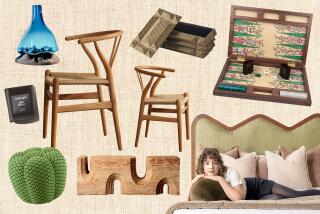Furniture Materials Run Gamut From Animal Horns to Wicker
Think of furniture, and you probably think of wood. But many other materials have also been used throughout the years. Designers are always striving to be different, so they often look at new materials to help inspire new designs. The new designs were often impossible until the new products were invented.
Antique lovers look for 18th and 19th century furniture made of bamboo, cast iron, wicker, animal horns, twigs, wire, and even ivory or silver. Collectors of 20th century furniture find top-quality pieces made of plywood, Lucite, fabric, steel, chrome and even blown-up plastic “bags.”
Cast iron was used for furniture in the early 19th century, and many of the tables and chairs were made for use outside. By the 1840s, stands, music racks, footstools and other small pieces of furniture were made in the elaborate shapes possible with metal. The attractive shapes made the iron popular, even though the heavy pieces were difficult to move. Soon, beds and tables became popular.
Now the iron pieces are often copied in lightweight, rustproof aluminum. This shows that modern materials can again be used to improve on old designs.
*
Question: Several years ago I purchased a pair of Art Deco silver-colored metalwork candlesticks for $10 at an estate sale in Chicago. The mark on the bottom of each includes the initials “WHW” within a circle above the phrase “Made in Austria.” Can you tell me who made the candlesticks and what they’re worth?
*
Answer: Your candlesticks were made by the Hagenauer Werkstdtte (German for “workshop”). The metalwork-design firm, founded by Carl Hagenauer (1872-1928), worked in Vienna from 1898 to 1956. Carl’s sons, Karl and Franz, ran the firm after their father’s death.
Your candlesticks probably date from the mid- to late 1920s, when the linear, geometric Art Deco style was popular. We suspect that your candlesticks are chrome- or nickel-plated bronze. They are worth much more than the $10 you paid for them--they could be worth as much as $1,000.
*
Q My father once owned a retail store. He still has the small office machine he used to make price tags. It has a hand crank, a drawer that holds all the original letters and numbers, a roll of blank tags and an ink bottle. It is marked “Monarch Pathfinder No. 27160.” Is there a market for this machine?
*
A Your father’s price-tag machine sounds as though it works like a miniature printing press. We have never seen one offered for sale. Old, portable office equipment does attract buyers at shows, flea markets and on the Internet.
The Monarch Pathfinder brand is still a well-known name in product labeling. The brand’s products include portable labeling machines that print and attach prepasted bar codes and price tags to cans and boxes.
*
Q When was the first Mickey Mouse watch made?
*
A The first Mickey Mouse wristwatch was made by the Ingersoll Co. They sold 2 1/2 million of them from June 1933 to June 1935. It was a popular watch with children, adults and even movie stars.
There was also an Ingersoll Mickey Mouse pocket watch with the same face as the wristwatch. The early watches had a second hand that showed three tiny Mickeys running in a circle. Mickey had a white face with a long nose. The later watches showed a pink-faced Mickey. The wristwatch and the pocket watch are worth about $500 each.
*
Q My small pottery vase is marked “Pigeon Forge Pottery” on the bottom. Have you ever heard of it?
*
A The Pigeon Forge Pottery is located in Pigeon Forge, Tenn., a town southeast of Knoxville. It has been working since 1946. The pottery makes molded or thrown vases, bowls, dishes and other slip-decorated, matte-glazed wares, including tiles. The artists who work there used red clay found in the area.
*
Q Is there really a heart-shaped ice cream scoop worth more than $4,000? When was it made?
*
A The heart-shaped ice cream scoop is the ultimate prize for any collector of scoops or ice cream collectibles. It was patented in 1925 by John Manos of Toronto, Ohio.
There was also a pear-shaped ice cream dish that was designed to hold the heart-shaped scoop of ice cream. Two types were made. It is claimed that there were only 500 of each model. One of the scoops did sell for $4,620 in a heated auction in 1988. Others have sold for less since.
*
Q My husband’s aunt left me an aluminum serving tray with a china insert in 1977. The china dish is white with a blue border and a bouquet of roses in the middle. The aluminum tray has two twisted handles and is decorated with a simple acorn-and-leaf design. The mark on the bottom of the tray is a “K” inside a keystone shape, surrounded by the words “Keystone Ware, Aluminum, Hand Hammered.” Can you give me any information?
*
A Trays like yours were popular during the 1950s. Farberware made most of them. Your Keystone Ware mark is familiar to collectors of aluminum, but the company did not last long. It could have been a short-lived subsidiary of a larger company.
The acorn-and-leaf design is commonly found on aluminum and other metal wares. The aluminum companies bought china inserts from various American potteries.
*
Q Can you please tell me the definition of a “rose bowl”? I’m not sure what collectors mean when they use the term.
*
A A rose bowl is a round, crimped glass vase with a turned-in edge at the top. It is almost round and has no feet. The origin of the rose bowl can be traced to the Victorian era (mid-19th century) in Europe and in America. The bowls were designed to hold short-stemmed roses and other flowers.
*
Q My large Elvis Presley ring is made of a gold-colored metal. There is a blue stone in the center, inset with a swordlike symbol. The words around the stone read “Elvis Aron Presley, The King.” One side of the ring has an image of Elvis and the other side pictures Graceland. I’m anxious to know if the ring is worth anything.
*
A The design in the center of your ring is a lightning bolt. Elvis sketched the symbol as his personal logo, which he called his “TCB lightning bolt.” (The letters stand for “taking care of business.”) Beverly Hills jeweler Schwartz & Ableser used the sketch to create high-quality jewelry for both men and women. The designs were widely copied after Presley’s death. If your ring is real gold, it will have a karat mark. If it does not, it is a reproduction made of a less valuable metal.
For a listing of helpful books and publications, include a self-addressed, stamped (55 cents) envelope to Kovels, Los Angeles Times, King Features Syndicate, 235 E. 45th St., New York, NY 10017.
(BEGIN TEXT OF INFOBOX / INFOGRAPHIC)
Current Prices
Figures are recorded from antique shows, flea markets, sales and auctions throughout the United States. Prices vary because of local economic conditions.
* Copper money clip, Frontier Hotel, Las Vegas, in oval, rope edging, 3/4 by 1 1/2 inches, $50.
* Kitchen butter mold, pineapple, round case marked “Pat’d April 17, 1865,” $60.
* Superman comic book, No. 36, September/October 1943, Lois Lane and Superman on cover, $95.
* Dollhouse furniture, china cabinet, oak, glass doors, 3 shelves, 1930s, 20 by 12 3/4 inches, $170.
* Paper counter display, “Blackstone, World’s Greatest Magician,” die-cut, appearing at His Majesty’s Theater, Montreal, 21 by 13 inches, $290.
* Redware bank, basket form, bird top, lift lid to remove money, 1970s, $415.
* Wolfgang Hoffman lounge chair, red Leatherette upholstery with chrome studs on cantilevered tubular frame, manufactured by Howell, 36 inches, pair, $990.
* Trifari dog clip, silver metal, clear pavi rhinestones, black, red, turquoise and white enameling, red and green cabochons, stamped, 4 inches, $1,210.
* Van Briggle vase, molded and carved flowers on long stems, green-and-blue matte glaze, incised mark, dated 1905, 7 inches, $2,100.
* Emerson tombstone radio, grille cloth, model No. AY-190, marbled green Catalan body, 1937, 6 by 10 inches, $3,850.


